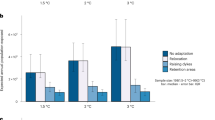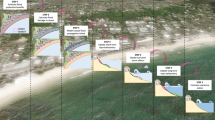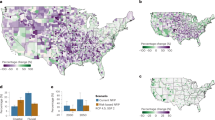Abstract
The risk of river flooding is expected to increase with climate change and socioeconomic development, and therefore additional protection measures are required to reduce the potential for increased flood damage. While studies have investigated the effectiveness of adaptation measures to reduce flood risks, none has evaluated residual flood damage (RFD), which reflects the projected increase in damage under intensive adaptation. Here we evaluate RFD under several adaptation objectives using an inundation model incorporating damage estimates and a cost–benefit analysis, and estimate that China, India and Latin American countries can achieve higher levels of flood protection that will reduce RFD even under extreme scenarios. However, a high RFD (exceeding 0.1% of subnational administrative gross domestic product) remains, especially in eastern China, northern India and central Africa. RFD could be reduced with shorter construction periods or lower adaptation costs, implying the need for immediate and appropriate adaptation actions, including enhanced financial support for high-risk regions.
This is a preview of subscription content, access via your institution
Access options
Access Nature and 54 other Nature Portfolio journals
Get Nature+, our best-value online-access subscription
$29.99 / 30 days
cancel any time
Subscribe to this journal
Receive 12 print issues and online access
$209.00 per year
only $17.42 per issue
Buy this article
- Purchase on Springer Link
- Instant access to full article PDF
Prices may be subject to local taxes which are calculated during checkout



Similar content being viewed by others
Data availability
Data generated and analysed during this study are available for research purposes at http://www.db.shibaura-it.ac.jp/~hirabayashi/research/Tanoue2021NCC. The S14 forcing dataset is from https://h08.nies.go.jp/s14/. The MATSIRO is downloadable from a password-protected CVS repository held by The University of Tokyo on request. The CaMa-Flood is from http://hydro.iis.u-tokyo.ac.jp/~yamadai/cama-flood/. The GRUPM population distribution and national mask are from https://sedac.ciesin.columbia.edu/data/collection/grump-v1. The future GDP per capita are from https://secure.iiasa.ac.at/web-apps/ene/SspDb/dsd?Action=htmlpage&page=welcome. Additional datasets used for the modelling are available from the corresponding author upon request.
Code availability
The code used for the modelling framework is available at http://www.db.shibaura-it.ac.jp/~hirabayashi/research/Tanoue2021NCC.
References
Arnell, N. W. & Lloyd-Hughes, B. The global-scale impacts of climate change on water resources and flooding under new climate and socio-economic scenarios. Clim. Change 122, 127–140 (2013).
Hirabayashi, Y. et al. Global flood risk under climate change. Nat. Clim. Change 3, 816–821 (2013).
Winsemius, H. C. et al. Global drivers of future river flood risk. Nat. Clim. Change 6, 381–385 (2015).
Alfieri, L. et al. Global projections of river flood risk in a warmer world. Earth’s Future 5, 171–182 (2017).
Alfieri, L., Dottori, F., Betts, R., Salamon, P. & Feyen, L. Multi-model projections of river flood risk in Europe under global warming. Climate 6, https://doi.org/10.3390/cli6010006 (2018)
Kinoshita, Y., Tanoue, M., Watanabe, S. & Hirabayashi, Y. Quantifying the effect of autonomous adaptation to global river flood projections: application to future flood risk assessments. Environ. Res. Lett. 13, https://doi.org/10.1088/1748-9326/aa9401 (2018)
Jongman, B. et al. Increasing stress on disaster-risk finance due to large floods. Nat. Clim. Change 4, 264–268 (2014).
Ward, P. J. et al. A global framework for future costs and benefits of river-flood protection in urban areas. Nat. Clim. Change 7, 642–646 (2017).
Scussolini, P. et al. FLOPROS: an evolving global database of flood protection standards. Nat. Hazards Earth Syst. Sci. 16, 1049–1061 (2016).
Kind, J. M. Economically efficient flood protection standards for the Netherlands. J. Flood Risk Manag. 7, 103–117 (2014).
Hirabayashi, Y., Tanoue, M., Sasaki, O., Zhou, X. & Yamazaki, D. Global exposure to flooding from the new CMIP6 climate model projections. Sci. Rep. 11, 3740 (2021).
Tanoue, M. et al. Estimation of direct and indirect economic losses caused by a flood with long-lasting inundation: application to the 2011 Thailand flood. Water Resour. Res. 56, https://doi.org/10.1029/2019wr026092 (2020)
Ciscar, J. C. et al. Physical and economic consequences of climate change in Europe. Proc. Natl Acad. Sci. USA 108, 2678–2683 (2011).
Koks, E. E., Bockarjova, M., de Moel, H. & Aerts, J. C. Integrated direct and indirect flood risk modeling: development and sensitivity analysis. Risk Anal. 35, 882–900 (2015).
Koks, E. E. et al. The macroeconomic impacts of future river flooding in Europe. Environ. Res. Lett. 14, https://doi.org/10.1088/1748-9326/ab3306 (2019).
Willner, S. N., Otto, C. & Levermann, A. Global economic response to river floods. Nat. Clim. Change 8, 594–598 (2018).
Dottori, F. et al. Increased human and economic losses from river flooding with anthropogenic warming. Nat. Clim. Change 8, 781–786 (2018).
Di Baldassarre, G. et al. Socio-hydrology: conceptualising human–flood interactions. Hydrol. Earth Syst. Sci. 17, 3295–3303 (2013).
White, G. Human Adjustment to Floods (University of Chicago Press, 1945).
Munoz, S. E. et al. Climatic control of Mississippi River flood hazard amplified by river engineering. Nature 556, 95–98 (2018).
Tanoue, M., Hirabayashi, Y. & Ikeuchi, H. Global-scale river flood vulnerability in the last 50 years. Sci. Rep. 6, 36021 (2016).
Jongman, B. et al. Declining vulnerability to river floods and the global benefits of adaptation. Proc. Natl Acad. Sci. USA 112, E2271–E2280 (2015).
Yamazaki, D., Kanae, S., Kim, H. & Oki, T. A physically based description of floodplain inundation dynamics in a global river routing model. Water Resour. Res. 47, https://doi.org/10.1029/2010wr009726 (2011)
Iizumi, T., Takikawa, H., Hirabayashi, Y., Hanasaki, N. & Nishimori, M. Contributions of different bias-correction methods and reference meteorological forcing data sets to uncertainty in projected temperature and precipitation extremes. J. Geophys. Res. Atmos. 122, 7800–7819 (2017).
Yamazaki, D., Sato, T., Kanae, S., Hirabayashi, Y. & Bates, P. D. Regional flood dynamics in a bifurcating mega delta simulated in a global river model. Geophys. Res. Lett. 41, 3127–3135 (2014).
Ikeuchi, H. et al. Modeling complex flow dynamics of fluvial floods exacerbated by sea level rise in the Ganges–Brahmaputra–Meghna Delta. Environ. Res. Lett. 10, https://doi.org/10.1088/1748-9326/10/12/124011 (2015)
Hosking, J. R. M. & Wallis, J. R. Regional Frequency Analysis: An Approach Based on L-moments (Cambridge University Press, 2005).
Huizinga, J., Moel, H. D. & Szewczyk, W. Global Flood Depth‐Damage Functions: Methodology and the Database with Guidelines (Joint Research Centre, 2017).
Willner, S. N., Levermann, A., Zhao, F. & Frieler, K. Adaptation required to preserve future high-end river flood risk at present levels. Sci. Adv. 4, eaao1914 (2018).
Arnell, N. W. et al. A global assessment of the effects of climate policy on the impacts of climate change. Nat. Clim. Change 3, 512–519 (2013).
Aerts, J. A Review of cost estimates for flood adaptation. Water 10, https://doi.org/10.3390/w10111646 (2018)
Lenk, S., Rybski, D., Heidrich, O., Dawson, R. J. & Kropp, J. P. Costs of sea dikes—regressions and uncertainty estimates. Nat. Hazards Earth Syst. Sci. 17, 765–779 (2017).
Jones, B. & O’Neill, B. C. Spatially explicit global population scenarios consistent with the Shared Socioeconomic Pathways. Environ. Res. Lett. 11, https://doi.org/10.1088/1748-9326/11/8/084003 (2016).
United Nations Demographic Yearbook (United Nations, 2005).
United Nations Demographic Yearbook (United Nations, 2008).
Acknowledgements
This research was supported by the Environment Research and Technology Development Fund (JPMEERF20202005) of the Environmental Restoration and Conservation Agency of Japan, a JSPS Grant-in-Aid for Scientific Research (18H01540), the Integrated Research Program for Advancing Climate Models (TOUGOU) (JPMXD0717935457) from the Ministry of Education, Culture, Sports, Science and Technology (MEXT), Japan and MS&AD InterRisk Research & Consulting, Inc. The authors are also grateful to the anonymous reviewers for providing valuable comments, which helped to improve the manuscript.
Author information
Authors and Affiliations
Contributions
M.T. developed the database, designed the modelling framework, conducted the analysis and made the figures. M.T. and Y.H. contributed to the analysis of results. R.T., H.A. and M.T. performed the inundation model simulations. M.T. and Y.H. wrote the manuscript.
Corresponding author
Ethics declarations
Competing interests
The authors declare no competing interests.
Additional information
Peer review information Nature Climate Change thanks Daniel Eisenberg and the other, anonymous, reviewer(s) for their contribution to the peer review of this work.
Publisher’s note Springer Nature remains neutral with regard to jurisdictional claims in published maps and institutional affiliations.
Supplementary information
Supplementary Information
Supplementary Figs. 1–18 and Tables 1–8.
Rights and permissions
About this article
Cite this article
Tanoue, M., Taguchi, R., Alifu, H. et al. Residual flood damage under intensive adaptation. Nat. Clim. Chang. 11, 823–826 (2021). https://doi.org/10.1038/s41558-021-01158-8
Received:
Accepted:
Published:
Issue Date:
DOI: https://doi.org/10.1038/s41558-021-01158-8
This article is cited by
-
Flood teleconnections from levees undermine disaster resilience
npj Natural Hazards (2024)
-
Cost-effective adaptation strategies to rising river flood risk in Europe
Nature Climate Change (2023)
-
Substantial increase in future fluvial flood risk projected in China’s major urban agglomerations
Communications Earth & Environment (2023)
-
Quantitative evaluation of flood damage methodologies under a portfolio of adaptation scenarios
Natural Hazards (2023)
-
Using Multidisciplinary Analysis to Develop Adaptation Options against Extreme Coastal Floods
International Journal of Disaster Risk Science (2022)



